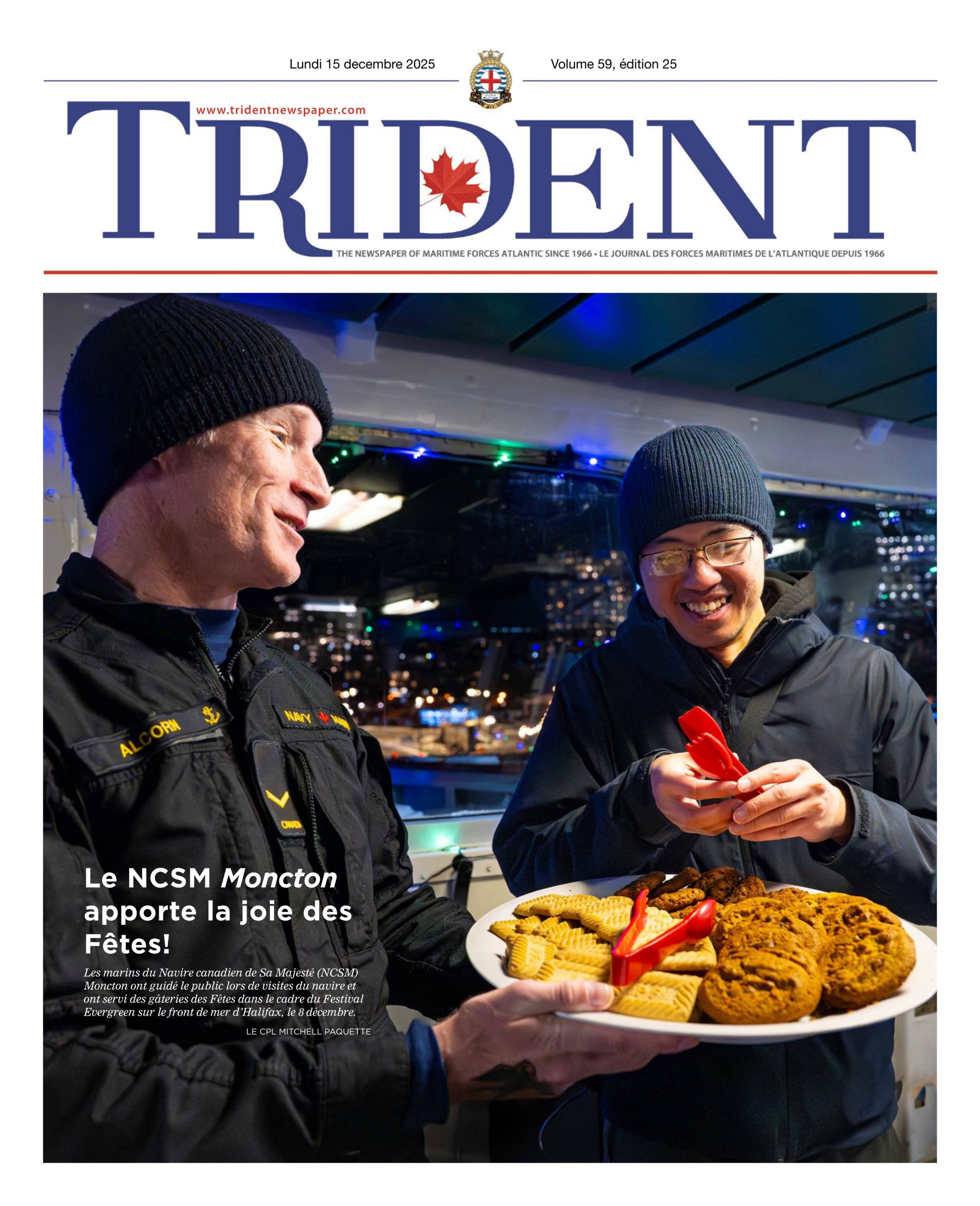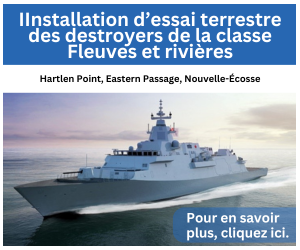
Photo: Joanna Calder
Lost Canadian Banshee pilot remembered at US naval base
By Joanna Calder,
RCAF Public Affairs
On February 25, 1958, Lt Barry Troy was part of a four-ship Royal Canadian Navy F2H-3 Banshee flight heading south along the coast of Florida from United States Naval Station Mayport outside Jacksonville. They were enroute to a point south of Jacksonville Beach where they would then turn and head back to HMCS Bonaventure, which was about 64 kilometres offshore.
Unexpectedly, a fog bank loomed ahead of the flight. The leader of the formation of fighters and the next two pilots turned right – westward towards land – and flew out of the fog bank within moments. Lt Troy turned left – eastwards over the Atlantic Ocean – presumably because he wasn’t sure of the location of the aircraft ahead of him and wanted to avoid a collision in the blinding fog. He was flying low and fast, probably only 500 feet (152 metres) above the water.
He was never seen again.
At the time, a few items were recovered from the Atlantic Ocean about two miles east of Jacksonville Beach: some paper, his helmet, his shaving kit and some fragments of wreckage. What became of these items following the conclusion of the Board of Inquiry into the incident is a mystery and, for six decades, nothing more was found.
Last autumn, fierce hurricanes swept through the area. Following the storms, a Jacksonville park ranger, Zachary Johnson, decided to investigate a bundle of debris near the high water line on Hanna Park beach in Jacksonville. From the NATO stock number on one of the items, he realized the bundle contained military items. “I knew I had found something special when I saw the lieutenant’s [name stencilled on one of the items],” he told a Jacksonville reporter.

Photo: DND Archives
Sixty years and one day after Lt Troy vanished, representatives of RCAF took custody of the historic items at a brief ceremony held at Mayport on the morning of February 26, 2018. Representatives of the RCAF, the RCN and the United States Navy (USN) attended the event, which was held near the beach, about a few kilometres north of the location where Lt Troy disappeared.
It was also an opportunity to thank Johnson and Officer Nolan Kea, of the Jacksonville Police Office (who has had custody of the items since last autumn) for their commitment to ensuring the safety of the artifacts.
An honoured guest was Dick Troy, accompanied by his wife Pauline. Troy was only 21 when his big brother Barry disappeared.
The ceremony opened with a low flypast of two USN Sea Hawk helicopters. “We are here this morning because of a hurricane,” said the master of ceremonies, Master Chief Bill Houlihan, command master chief at Naval Station Mayport. “We are here because, just as the sea sometimes takes, it also gives back. Today we can look to the sea and say thank you for providing what some military families never receive, and that is closure.”
RAdm Sean Buck, Commander of the US Naval Forces Southern Command and Commander of the US 4th Fleet, welcomed the Canadians to Mayport.
“We are going to have the opportunity to celebrate humanity, sacrifice, and an enduring and strong bond between two nations: Canada and the United States. We celebrate the humanity of individuals as well as nations. We celebrate the sacrifice of individuals, as well as nations . . . . and we give thanks to all the men and women who have chosen to wear the cloth of our respective nations.”
The recovered items include an oxygen tank, a parachute, parachute cover and parachute harness, an inflatable life vest and life vest straps, and small pieces of the aircraft. Lt Troy’s name is written on the life jacket straps. Given the condition of the items, it is thought that the items may have been washed ashore at some point after the crash and buried beneath the dunes for years before being uncovered by the 2017 storms.
“We’ve grieved all these years,” said Troy, who lives in California. “We were a very close-knit family, and this settles in our mind exactly happened. I’m amazed at what they did find and the fact that his name was on that [strap] after 60 years. . . . which brought us to this day.
“When I touched that ‘chute and harness . . . knowing it was his body that last wore that ‘chute, it’s some kind of connection. It sends chills through me, but it’s a good feeling.”
Col Tom Dunne, Canadian air attaché at the Embassy of Canada in Washington, thanked Ranger Johnson and Officer Kea and presented them with signed letters of appreciation from the commander of the RCAF, LGen Michael Hood, as well as other mementos.
Following the formal remarks, the base chaplain offered prayers, a USN bugler played the Last Post and a minute of silence was held. Then, in a brief but moving moment, a USN sailor presented Troy with a folded Canadian flag. The flag had been flown at the Embassy of Canada in Washington the day before, on the 60th anniversary of Lt Troy’s death.
After the morning’s events were concluded, Officer Kea signed over the items, which he had secured in the Jacksonville Police evidence lockup, to Dr. Richard Mayne, senior historian for the RCAF. Christine Hines, curator of the Shearwater Aviation Museum in Nova Scotia, where the artifacts will find a permanent home, carefully packed the items for shipment back to Canada.
At the time of Lt Troy’s death, maritime air was the responsibility of the RCN. Now, all CAF aviation assets and missions fall under the RCAF. Both the Air Force and the Navy, therefore, consider Lt Troy to be one of their own. When these artifacts are ultimately taken into the care of the aviation museum in Shearwater, they will be returning to Lt Troy’s home base, which is now an Air Force Wing.
Lt William Thomas Barry Troy, Royal Canadian Navy
Barry Troy was born December 6, 1928, in Chatham, New Brunswick, the son of J. Thomas and Lilian M. Troy.
He attended St. Francis Xavier University in Antigonish where he joined a university military training program in 1947. After graduating in 1951, he joined the RCN, first as a deck officer. “He then decided he wanted to be a pilot,” said his brother, Dick Troy. In 1958, Barry Troy was a member of RCN’s VF-871 (871 Squadron), based at Shearwater, Nova Scotia, flying the McDonnell F2H-3 Banshee fighter jet.
In 1952, the RCN had adopted USN designators for its squadrons, so V designated heavier-than-air squadrons, S designated anti-submarine squadrons and F designated fighter squadrons. Therefore, VF indicates a heavier-than-air fighter squadron.
“My Mum and Dad grieved for years,” said Troy. “I think they would be very honoured by what happened here today.
“Barry was bigger than life, an impressive guy,” he continued. “Everybody liked him and he was somebody who you could look up to [and] the kind of guy who never gave up.” Under his photo in the St. Francis Xavier yearbook, says Troy, were written the words “The grandest guy at StFX”.
The crash
In early 1958, Bonaventure, a Canadian aircraft carrier that had been commissioned about 13 months before, was in the Mayport area. It was carrying Grumman S-2F Tracker aircraft and Sikorsky HO4S helicopters from naval anti-submarine warfare (ASW) squadrons, based at Shearwater, that were exercising in their ASW role.
Banshees from VF-871 left Shearwater in mid-February, heading toward Mayport and the Bonaventure. There, VF-871 Squadron exchanged places with the ASW squadrons and the Banshee pilots began work on their aircraft carrier qualifications. VF-871 operated from the Bonnie, with Mayport as an alternate landing place. Later, the squadron would fly to Charleston, South Carolina, to rejoin the Bonaventure and prepare for Exercise MAPLE ROYAL, a Canadian 12-ship exercise to be held in the Bermuda area.
At about 11 a.m. on Tuesday, February 25, a flight of four Banshees, under the leadership of LCdr J.J. Harvie, departed from Mayport to return to the Bonnie. The weather earlier in the day had been foggy, but the meteorological report from Mayport indicated the fog had lifted and the flight could take place. The plan was to fly south along the coastline to a point south of Jacksonville Beach, where the four aircraft would form up, and then go into a left-hand circuit (initially turning an eastward direction over the ocean) and then transit to the ship.
The #2 Banshee had formed up with the lead aircraft and #3 was joining up. But then, “as I closed on [Jacksonville] Beach, I saw this fog bank ahead,” LCdr Harvie told the Board of Inquiry, convened on March 8, 1958. The meteorological office had not been aware of the fog bank and it came as a surprise to the lead pilot. “By the time I saw it, it was too late to do a turn with the flight forming as it was, so I told #3 to turn right on to [heading] 270 (editor’s note: that is, towards land on the right) . . . I looked back to see where #4 [Lt Troy] was and I did not see him.
“It would seem that [Lt Troy] was following me to join up. When I went into the fog bank he went into a left hand turn [toward the ocean] into the fog bank . . . and he didn’t come out of it.”
From this and other testimony, and in the absence of any eye witnesses, the Board of Inquiry deduced that Lt Troy had probably turned left to ensure he avoided the other three Banshees turning right ahead of him. “The board considers that the following is the most probably sequence of events. When the leader of the formation disappeared into the fog bank, [Lt] Troy had not yet joined, but could well have been closing rapidly. When [Lt] Troy entered cloud, he probably turned left to avoid the formation ahead, which he would know by the transmission of his leader to be turning right. [He] became disoriented on instruments and crashed in the sea.”
The board also indicated that they found “the flight was properly planned, briefed, and authorized in the light of the then-existing and forecast weather conditions”.
In their findings, the board absolved Lt Troy, finding “that [Lt] Troy was not to blame for the accident, that all flying and aircraft maintenance orders . . . were complied with, and that the aircraft was serviceable for the flight as planned.
“The cause of the accident was disorientation while on instruments, following an unexpected entry into cloud at low altitude,” the board concluded.
Closure
Lt Troy’s name is inscribed on a memorial “dedicated to the men and women who died while serving with the Canadian Navy during peacetime” in Point Pleasant Park, Halifax, Nova Scotia. Dick Troy and some of his siblings visited the memorial, which features Bonaventure’s anchor and cable, several years ago.
Lt Troy’s name and the words “lost at sea” are inscribed on his parents’ gravestone, but, although a memorial service was held at the time he died, there were no remains to inter. At the ceremony, Dick Troy was given a part of the downed Banshee which he and his siblings now plan to bury in their parents’ grave plot.
“He was our hero, our big brother. We lost him, and now we have him back in a way. So there’s some finality, a closure, to what happened 60 years ago,” said Troy.






